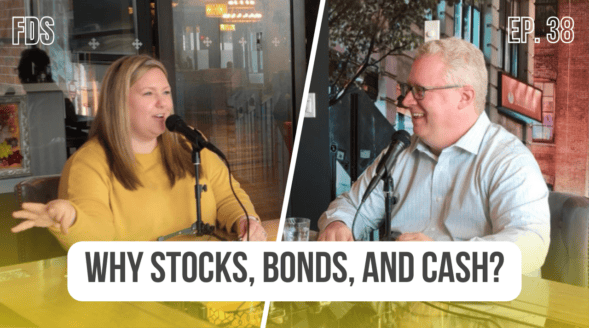All About I-Bonds: What Are They & Interest Rates [Video]
by Financial Design Studio, Inc. / February 13, 2023You’ve heard about them on the news. Everyone is talking about them. But are they right for you? I’m talking about i-bonds and their interest rates.
Today I’m going to talk to you about i-bonds. We will consider what they are, how they work, and then weigh the pros and cons. You will want to read to the end to see if this might be a savings tool for you!
What Are I-Bonds?
In 2022, last year, i-bonds were everywhere. This is because inflation was rising. Like the name states, the “i” in “i-bond” stands for inflation. These are savings instruments issued by the US Treasury. But they are a little bit different than other US Treasury bills, notes or bonds that you’ve heard of or seen the ticker for on exchanges.
I-bonds are purchased directly through the US Treasury department. They index for inflation. So there are two components that go into an i-bond. One is a fixed rate, which for a long time has been zero. It’s just over zero right now.
Why the I-Bond Craze?
But the rate that everyone pays attention to is the inflation adjustment. These were all the rage last year because of this. In fact, there was a rush to buy these at the end of October 2022. The inflation adjustment rate on the i-bond resets every November first and May first. So, coming up here May first, these are going to reset. The reason these were so attractive is they were paying 9.62% in the middle of last year, between May and November. Now they are still attractive at 6.89% a month.
So if you were to purchase an i-bond, you would get a 6.89% return. Not bad right? It’s still more than most bonds out there, and a great place to park some money.
What are the Limits?
There are limits. One thing with i-bonds is that you can only purchase up to $10,000 per year, per person. Now there are some nuances there. For instance, if you have a trust, you can purchase an additional $10,0000. If you are getting a tax refund, you can have a bond issued up to 5,000 as the refund. But just know, there is a limit: $10,000 per year, per person.
Again, like I mentioned the rate changes. It changes on May first as well as November first every year. Essentially what you are doing is locking in a six month interest rate on those bonds.
So this all sounds pretty good right? Almost 7%? That’s better than a savings account and better than a lot of other bonds on the market. It really proves cash is king, and there are a lot of opportunities to earn more! But are i-bonds really right for you and a good place for you to put your money?
Let’s weigh the pros and cons when it comes to i-bonds. The pros are pretty obvious. That 6.89% of very attractive interest is very very hard to beat. They are backed by the US treasury, plus FDIC insured. This is a very safe place to put money.
What are other things to consider? Like I said before, there are limits. So this is something that you are going to be able to put your 10k a year into and no more. One other limit is you can’t just buy these through your Schwab or Vanguard brokerage account.
You have to go through a very specific website, treasurydirect.gov, to buy them directly from the US government. You may be thinking, “that doesn’t sound like a big deal.” But this is just one more account you will have to set up and manage. That is something you have to consider.
When Can I Take Money Out?
One other limitation with i bonds is that your money is locked up. These are technically 30 year bonds, but if you hold it for five years, you can take your principal out. Let’s say you’ve put $10,000 in. You can take out that contribution, that principal, out and all the interest, which accrues monthly.
But your money is locked up for those five years. There is a caveat here. Let’s say you take it out in one year. You are able to do this with your i-bond but you will lose three months of interest if you take it out between one year and five years.
Just to recap, they are technically meant to hold for the long term. But five years is the year you are anchoring to. If you need it less than that, you must keep them invested for at least a year, then you have to pay 3 months of interest back.
Are I-Bonds Right for You?
In weighing pros and cons, who are i-bonds right for? Let’s think about it this way.
As you save your money, you save it for another date on the timeline. Emergency funds are for right now, while retirement savings are for the future. I-bonds fall in the intermediate bucket.
Make sure you get your emergency fund fully funded, in liquid cash, in a high yield account. That money should stay there. We have a great video on this process if you want to learn more! Once you’ve got an emergency fund, maybe you have some extra cash that you don’t want to put into the stock market.
This could be a great situation where you can park the money in an i-bond for 5 years so it gathers interest. One thing to bear in mind is that this interest rate number resets every couple months. If inflation drops, like it did between 2022 and 2023, that number will go down. The inflation adjustment number is the highest we’ve seen since the early 80s.
Next Steps for Considering I-Bonds.
These are things you need to weigh. Think about your money being locked up for at least 5 years, it’s not liquid, and your rate is going to fluctuate every six months. Keeping those things in mind, you have both limitations and positives. This is something to talk about with your certified financial planner about to see if and when it may fit into your plan. I hope you learned something about i-bonds today!
If you still have questions about what you should do with your money, then reach out! We would love to bring you confidence in your finances.
Ready to take the next step?
Schedule a quick call with our financial advisors.


